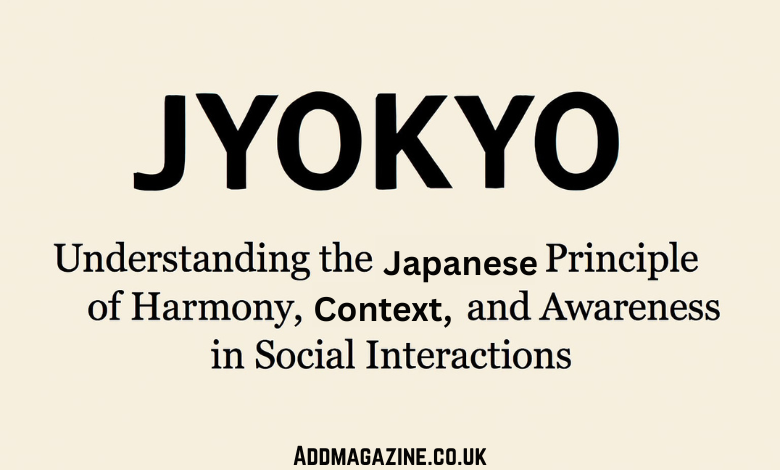In the rich tapestry of Japanese culture, one term that stands out for its profound impact on daily interactions is jyokyo. While this term doesn’t have a direct English translation, its significance goes beyond mere words. Jyokyo encapsulates the intricate relationship between context, environment, and interpersonal dynamics in Japan. It is not just about the situation at hand, but how individuals adjust their behavior to maintain harmony and respect for others. This concept is deeply ingrained in the cultural psyche of the Japanese people and influences communication, social norms, and daily life. In this post, we will explore what jyokyo is, how it shapes interactions in Japanese society, and its ties to core cultural values such as harmony, balance, and awareness.
What is Jyokyo?
At its core, jyokyo is a Japanese term that emphasizes the importance of understanding the context in which something is happening. It’s not simply about a situation, but rather about how people perceive and respond to the environment and the people around them. In practice, jyokyo reflects a deep awareness of both the external circumstances and the unspoken, subtle cues that define social situations.
The literal meaning of jyokyo might not convey its full essence. While it can be loosely translated to something like “situation” or “circumstance,” the term is more layered than that. It is about grasping the essence of a scenario and adapting one’s actions to ensure that the interaction remains respectful, balanced, and harmonious.
This understanding is integral to Japanese communication, where indirectness and restraint often take precedence over directness and assertiveness. Jyokyo asks individuals to consider the emotional and social context of their actions, making them more sensitive to the feelings and needs of those around them.
The Role of Context in Jyokyo
In Japan, context is everything. Jyokyo is a perfect example of how the Japanese regard the surrounding environment and the dynamics between individuals in any given situation. For instance, the way a conversation unfolds is often influenced by various contextual factors, such as the relationship between the speakers, their age, their social standing, and the setting in which the conversation takes place.
A conversation with a superior, for example, would be approached with a high degree of respect and deference, with minimal direct confrontation. On the other hand, a conversation with a close friend might allow for more openness and casualness. The goal is always to ensure that the harmony within the relationship is maintained. Whether in a business meeting, at home, or in a social gathering, jyokyo dictates that one must be attuned to the nuances of the situation and behave accordingly.
Example of Jyokyo in Communication
Consider a scenario in a business setting in Japan. A senior executive may say, “It’s fine, but we could improve.” While this may seem like a gentle suggestion in other cultures, in Japan, the response would be carefully evaluated for its jyokyo. The team members would not take this comment at face value but would instead understand it in the context of what has not been said — that improvements are expected, and there is an underlying urgency.
This subtlety in language and action is what makes jyokyo so important. The unspoken element often conveys more meaning than what is directly said.
Harmony and Balance: The Heart of Jyokyo
One of the core values that jyokyo ties into is harmony (和, wa). Japanese society places a high value on avoiding conflict and maintaining peace in all aspects of life, whether at work, with friends, or within the family. In any social situation, ensuring that the peace is preserved is of utmost importance.
Jyokyo, then, is deeply connected to this value of harmony. By taking into account the broader context and reacting in a way that does not disrupt the flow of interactions, individuals contribute to a peaceful environment. This harmony is not just about avoiding conflict; it’s about fostering understanding and cooperation through shared awareness of the situation.
Balance (chōwa) is another crucial element in this concept. Life in Japan is about balancing various roles, responsibilities, and expectations. Jyokyo encourages individuals to adapt their actions to achieve balance in social exchanges. A person’s behavior should never overshadow or disrupt the group dynamic but should instead enhance collective cohesion.
For instance, during a group dinner, it is customary to wait for the eldest member or the host to begin eating. This respect for hierarchy is an example of jyokyo in practice, where individuals maintain balance by adjusting their actions to suit the social context.
Awareness: A Key Element of Jyokyo
In addition to context and harmony, awareness (気配り, kikubari) is a critical aspect of jyokyo. Awareness in this sense is not limited to being mindful of one’s own actions but extends to being conscious of the feelings, comfort, and needs of others. It is the ability to sense the emotional atmosphere in a room and adjust one’s behavior accordingly. This empathetic awareness allows individuals to navigate situations with a sensitivity that fosters positive interactions and relationships.
Awareness, as it relates to jyokyo, involves both self-awareness and situational awareness. A person who is aware of their own emotions, behaviors, and the environment around them is better equipped to understand the subtleties of any given situation. They can respond in a way that is appropriate, avoiding actions that might disrupt the peace or make others uncomfortable.
Awareness in Social Interactions
In social situations, jyokyo manifests in how people adjust to the mood or tone of a gathering. If someone notices that a conversation is becoming tense, they might introduce a lighter topic to diffuse the situation. Or, if a person feels that they are dominating the conversation, they might step back and allow others to speak. Such acts of awareness are key to maintaining harmony and balance, showing respect for others’ emotional states.
The Influence of Jyokyo on Japanese Work Culture
In Japan, work culture is heavily shaped by jyokyo. A key principle in Japanese corporate life is the importance of teamwork and collective effort. In a group setting, individuals are expected to act in ways that contribute to the group’s overall success and unity, rather than pursuing personal gain.
The value of jyokyo can be seen in practices such as nemawashi, which involves informal discussions and groundwork done before a formal meeting to ensure that all opinions are considered and that everyone is on the same page. This preparatory work is rooted in the idea of maintaining harmony and consensus, ensuring that no one feels left out or disregarded.
Moreover, jyokyo also influences the hierarchical nature of Japanese workplaces. Seniority plays a significant role in determining how individuals interact. Younger employees are expected to show deference to their elders, even in situations where they might disagree. This hierarchical structure, based on mutual respect and awareness of the social context, ensures smooth and harmonious relationships within the workplace.
Jyokyo and Modern Japan
As Japan continues to modernize, jyokyo remains a vital part of the national identity. Despite the global influences of technology and Western culture, Japanese society has managed to preserve its core cultural values, and jyokyo remains a fundamental guiding principle in social interactions.
However, in recent years, there has been a shift, especially among younger generations. The rise of digital communication and globalization has led to a more direct form of communication, especially in the workplace. Yet, jyokyo still influences the way people interact in both professional and personal settings, ensuring that the spirit of harmony and awareness is never lost.
The Global Relevance of Jyokyo
While jyokyo is inherently tied to Japan, its concepts are not limited to Japanese culture alone. The emphasis on context, harmony, and awareness is a universal principle that can benefit global communication. In today’s interconnected world, where interactions often span across cultures, understanding jyokyo can improve cross-cultural communication and foster a more respectful and cooperative environment.
By applying the principles of jyokyo — understanding the situation, balancing personal actions with group harmony, and being aware of others’ emotional states — individuals around the world can cultivate more empathetic and effective relationships, both personally and professionally.
Conclusion
Jyokyo is a term that goes beyond words. It is a concept deeply embedded in the fabric of Japanese society, reflecting how individuals adapt their behavior based on the situation and the people around them. Rooted in the values of harmony, balance, and awareness, jyokyo influences every aspect of social and professional life in Japan. It is a reminder that communication is not just about what is said but about how one reacts and adjusts to the surrounding context, ensuring that everyone is respected and that peace is maintained. While jyokyo is deeply rooted in Japanese culture, its principles can be applied universally to improve interactions and foster understanding in an increasingly globalized world.




